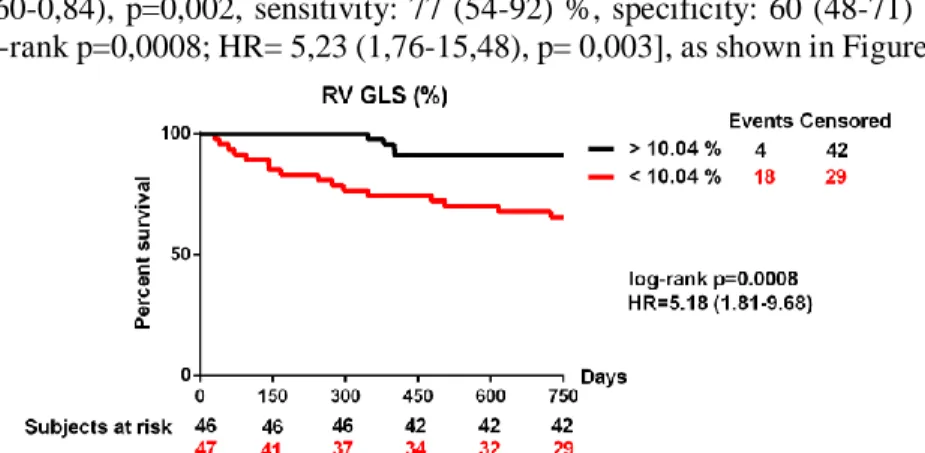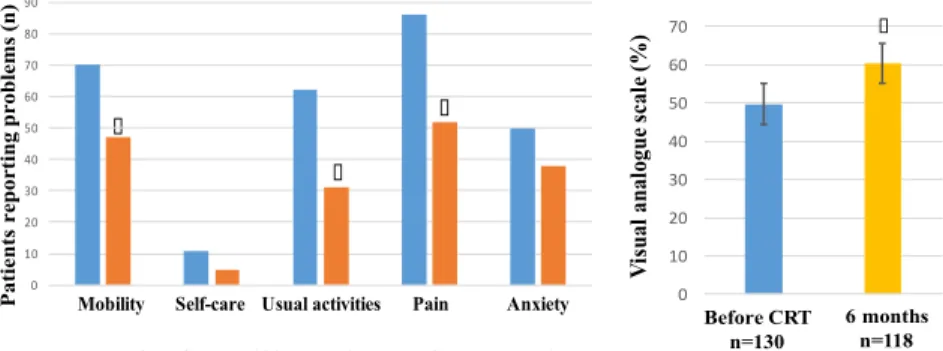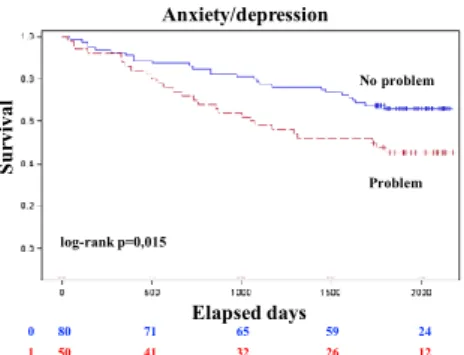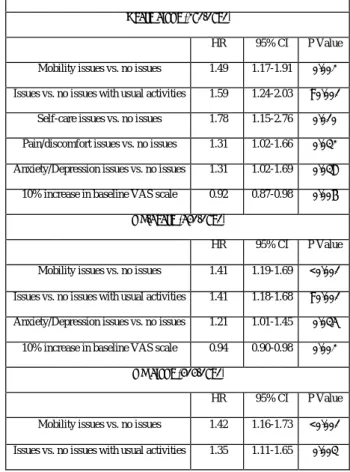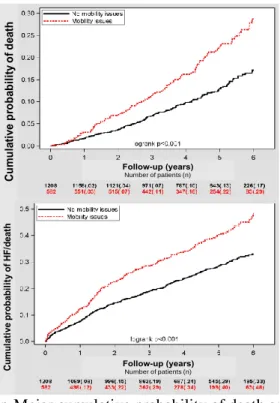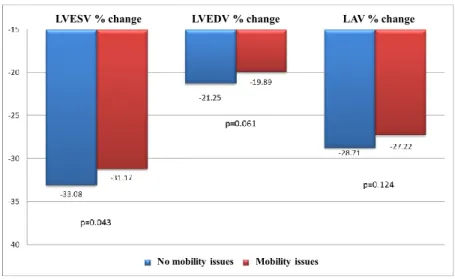0
NOVEL PROGNOSTIC FACTORS IN CHRONIC SYSTOLIC HEART FAILURE PATIENTS WITH CARDIAC RESYNCHRONISATION THERAPY
PhD Thesis
Klaudia Vivien Nagy, MD
Doctoral School of Basic and Translational Medicine Semmelweis University
Supervisors: Béla Merkely, MD, DSc Gábor Széplaki, MD, PhD
Official reviewers: Gergely Szabó, MD, PhD Róbert Pap, MD, PhD
Head of the Final Examination Committee:
László Rosivall, MD, DSc
Members of the Final Examination Committee:
Albert Varga, MD, DSc Beatrix Sármán, MD, PhD
Budapest
20181 INTRODUCTION
Chronic systolic heart failure (HF) is a disease with high mortality rate, which can reach 20%, despite of modern pharmacological and non- pharmacological treatment. However, the clinical outcome of HF patients is different. Thus, it is important to identify those factors, which are associated with higher morbidity and mortality, because patients in risk may need more frequent follow-ups and more agressive treatments.
Cardiac resynchronisation therapy (CRT) is a special pacemaker, which terminates mechanical intraventricular dyssynchrony caused by left bundle branch block (LBBB). About 20% of CRT patients are "super- responders" which means that left ventricular function and geometry normalises after implantation. However, despite of proper indication 40-50%
of patients are non-responders, among them no significant reverse remodelling, or clinical improvement can be observed 6 months after implantation. Several factors have been identified, as significant predictors of morbidity and mortality, clinical response and reverse remodelling. Earlier investigations showed, that right ventricular (RV) function is an important prognostic factor in moderate and severe heart failure. However, less data is provided on the predictive value of RV function among CRT implanted patients. Furthermore, it is also known, that heart failure decreases quality of life. After CRT implantation as part of positive response quality of life improves. But las data is available about the predictive role of quality of life in CRT patients. Careful selection of CRT candidates is utmost important to maximise the therapeutic benefit and minimise the risk. One the one hand those patients should be chosen, who can gain certain benefit, because the patient is not too fragile, are motivated and able to actively take part in the healing process. The ability of doing their everyday activities, no mobility or self-care difficulties, and generally how they individually estimate their own health state may predict good clinical response. On the other hand, those patients should be selected, in whom CRT therapy could be effective, because there are no such influencing factors present, which can not be improved with CRT treatment. One good example is the rigfht ventricular function, because CRT treatment most likely only has indirect effect on right ventricular function.
2 OBJECTIVES OF OUR STUDIES
The main purpose of our studies was to identify novel echocardiographic and clinical parameters in chronic systolic heart failure patients implanted with cardiac reseynchronisation therapy, which can predict poor prognosis, higher mortality as well as lack of clinical response and reverse remodelling before CRT implantation.
With this background we aimed to answer the following clinical questions:
1. If right ventricular function measured before CRT implantation in moderate and severe systolic heart failure patients (NYHA II-IVa) has predictive role in
a) short-term (6 months),
b) and two years all-cause mortality.
2. If quality of life determined before CRT implantation and change in quality of life at 6 months follow-up in moderate and severe systolic heart failure patients (NYHA II-IVa) could predict
a) 5 years all-cause mortality, b) clinical response
c) and reverse remodelling determined at 6 months after implantation.
3. If in a large cohort of asymptomatic and mildly symptomatic systolic heart failure patients (NYHA I-II) enrolled in the MADIT-CRT randomised, multicentric, clinical trial quality of life determined at enrollment has prognostic significance in
a) long-term all-cause mortality, b) heart failure events, and
c) combined end-point of all-cause mortality and heart failure events.
3 METHODS
Investigational plan of our single centre, prospective, follow-up study
We enrolled 141 patients to our single centre, prospective, observational study, who were implanted with CRT device between September 2009 and December 2010 based on the actual CRT indications.
Before the enrollment, all patients signed written informed consent. The study adhered to the Declaration of Helsinki and was approved by the local ethics committee of the Semmelweis University. This work was supported by the National Development Agency of Hungary (‘Semmelweis Egyetem Híd Projekt’ (TÁMOP-4.2.2-08/1/KMR-2008-0004), ’Semmelweis Egyetem Magiszter Program’ (TÁMOP-4.2.2./B10/1.-210-0013), the János Bolyai Research Scholarship of the Hungarian Academy of Sciences (GS, LG) and the Hungarian Scientific Research Found (OTKA K 105555).
According to the current guidelines in that period, the inclusion criteria were as follows: congestive, symptomatic heart failure [New York Heart Association (NYHA) II-IVa functional class] treated with maximal tolerated medical therapy for at least 3 months. Left ventricular ejection fraction (LVEF) below 35%, QRS duration broader than 120 ms, measured on surface electrocardiogram (ECG) using the widest QRS complex from II, V1 and V6 leads.
At baseline, prior to CRT implant medical history was obtained, EQ-5D questionnaire completion, physical examination, ECG recording and echocardiography were performed. All patients underwent successful CRT- P (pacemaker only CRT) or CRT-D (CRT with implantable cardioverter defibrillator) implantation. At the 6-month and 24-month follow-up physical status was examined, ECG, laboratory tests, echocardiography and device interrogation were performed. We continued patient clinical follow-up until 5 years. The primary end-point was all-cause mortality, which was assessed at 6 months (short-term mortality), at 24 months (mid-therm mortality) and at 5 years (long-term mortality) after CRT implantation. Reverse remodelling was defined as an absolute 15% reduction in left ventricular end- systolic volume (LVESV), while clinical response was determined with at least one class improvement in New York Heart Association (NYHA) status and lack of heart failure hospitalisation at 6 months following implantation.
4
Echocardiography and Strain Imaging
We performed transthoracic echocardiography with a commercially available cardiovascular ultrasound system (iE33, Philips Healthcare, Best, The Netherlands). The present echocardiographic sub-study included 93 patients, who consented to undergo detailed echocardiographic examination and whose echaocardiographic images werre available for further analysis.
Guidelines proposed by the American College of Echocardiography were used to evaluate right ventricular dimensions and function. We performed off-line analysis of the acquired cine-loops by an independent cardiologist expert using a commercially available software (QLab, version 9.0, Philips, Andover, MA, USA). To assess the regional and global RV systolic function, a 7-segment RV model was deployed (basal RV free wall, mid RV free wall, apical RV free wall, apex, apical septum, mid septum and basal septum). We calculated RV global longitudinal strain (GLS) as the average value of the peak systolic strain of the segments. RV free wall strain was generated by making the average value of the peak systolic strains of the 3 free RV wall segments.
EuroQoL 5 dimensions (EQ-5D) questionnaire
The official Hungarian version of the EQ-5D questionnaire was filled out before and 6 months after CRT implantation by the patients. Seven patients did not consent to complete QOL questionnaire or had incomplete data, thus altogether 130 patients were included in the present analysis. The EQ-5D is a self-administered, generic, validated, multi-attribute preference-based, utility instrument to measure QoL. The questionnaire consists of five measures, mobility, self-care, usual activities, pain/discomfort and anxiety/depression. All domains have three levels: no, some and extreme problems. Respondents were asked to rate the severity of their current issues (level 1 = none, level 2 = some/moderate, level 3 = severe/extreme). It also includes a single-index visual analogue (VAS) scale for global assessment of health status, where patients can individually estimate their own health state between 0 (“worst imaginable health status”) and 100 (“best imaginable health status”).
5
Lomg-term follow up of the MADIT-CRT clinical trial
In the MADIT-CRT (Multicenter Automatic Defibrillator Implantation Trial with Cardiac Resynchronization Therapy) international, multicenter, prospective clinical trial 1820 patients with ischemic cardiomyopathy (New York Heart Association (NYHA) functional class I or II), or non-ischemic cardiomyopathy (NHYA functional class II), a left ventricular ejection fraction of less than 30%, and a QRS duration130 ms in sinus rhythm were enrolled and randomized to CRT-D or ICD arms in a 3:2 ratio. In this study, 110 centers from North America and Europe enrolled subjects. The MADIT- CRT clinical trial was conducted from December 22, 2004 through September, 2010. After September 10, 2010 a long-term follow-up was initiated, wherein 854 patients were involved. The median long-term follow- up was 5,6 years. All patients underwent clinical evaluation at all in-clinic follow up visits or at any significant clinical event.
In this sub-study, all MADIT-CRT patients from both the CRT-D and ICD arms were included we only excluded patients with no quality of life questionnaire data available. A total of 1791 of 1829 (98%) patients had their QoL evaluated at baseline using the EuroQol-5 Dimensions (EQ-5D), and 1790 patients (98%) completed the Kansas City Cardiomyopathy Questionnaires (KCCQ).
Patients completed two different quality of life questionnaires at baseline, before CRT implantation. The detailed description of the short and whidespread used EQ-5D could be read above. There was another HF- specific QoL instrument, the Kansas City Cardiomyopathy Questionnaire (KCCQ) additionally utilized. The KCCQ questionnaire includes 6 basic scales consisting of Symptom Stability, Symptom Frequency, Symptom Burden, Physical Limitation (PL), Quality of Life, and Social Limitation scales. Using these scales, three summary scales can be calculated including the Total Symptom, Clinical Summary (CS), and Overall Summary scores.
For the present analysis, we have chosen to analyze the Clinical Summary and Physical Limitation scores, as the most representative parameters in our patient population.
The primary end point of this sub-study was all-cause mortality.
Secondary end points were the first occurrence of a heart failure event or death from any cause, and heart failure events alone. HF events were defined as symptoms and/or signs consistent with congestive HF and (1) need for intravenous diuretic therapy greater than 2 hours without hospitalization or (2) need for an augmented HF treatment with oral or iv. medication during an in-hospital stay.
6
Patients were grouped into two sub-categories based on the presence or absence of baseline issues within the different domains of the EQ-5D questionnaire. They were then categorized into two groups based on their tertiles KCCQ Clinical Scores (CS), and Physical Limitation scores (PL).
The first tertile was compared to the second and third tertiles for each value.
Statistical analysis
Continuous variables are expressed as mean ± standard deviation, or in case of differing from normal distribution are presented as medians and interquartile ranges. Whereas categorical data are shown as frequencies and percentages. All statistical analyses were two-sided and a p-value of <0,05 was considered statistically significant. Data analysis was performed with Graphpad Prism 6.03 (GraphPad Softwares Inc., USA), IBM SPSS 21 (Apache Software Foundation, USA) and SAS software (version 9.4, SAS institute, Cary, North Carolina).
Role of right ventricular global longitudinal strain in predicting early and long-term mortality in CRT patients
We used for group comparison the Mann-Whitney or Wilcoxon-test for continuous variables and the Chi-squared test for dichotomous variables. We performed receiver operating characteristics (ROC) curve analysis to define optimal cut-off values. We set up multivariable Cox regression models in a forward stepwise way: the first model (M1) included those variables that were statistically significant in the univariate analysis; the second model (M2) comprised covariates with proven relevance in chronic heart failure.
The predictive value of quality of life measured with EQ-5D questionnaire on long-term mortality, clinical response and reverse remodelling
The evaluation of EQ-5D questionnaire was simplified, meaning that the presence of some and extreme problem categories were not assessed separately regarding the five elements. The subgroups were compared using the Chi-squared test. We constructed a multivariable Cox model, those variables were included, which were statistically significant with univariate Cox analysis. Logarithmic transformation of continuous variables was used, ranked and then standardized by one standard deviation increase. In the multivariable Cox analyses, forward stepwise models were applied to find independent predictors of mortality. The proportional hazard assumption was
7
evaluated using Schoenfeld residuals for continuous covariates and Log minus log plots for categorical variables.
Quality of Life Predicting Long-Term Outcomes in the MADIT-CRT patient population
Baseline clinical parameters were compared between the subgroups of patients with issues vs. no issues of the EQ-5D mobility domain, and between patients with tertiles of KCCQ clinical score, using the Wilcoxon rank-sum test for continuous and 2 - test or Fisher exact test for dichotomous variables. Cumulative probabilities of all-cause mortality, HF/death and HF alone were displayed in the total MADIT-CRT patient population by baseline issues vs. no issues of EQ-5D mobility domain, or by the baseline KCCQ clinical score tertiles according to the Kaplan-Meier method with cumulative event rates compared by the log-rank test.
Multivariate Cox proportional hazards regression analysis was used to evaluate the association of baseline issues of the EQ-5D mobility domain and the baseline value of KCCQ clinical score by median with the risk of primary and secondary outcomes.
RESULTS
ROLE OF RIGHT VENTRICULAR GLOBAL LONGITUDINAL STRAIN IN PREDICTING EARLY AND LONG-TERM
MORTALITY IN CRT PATIENTS
Baseline clinical characteristicsThe baseline clinical characteristics of the 93 patients are shown in Table 1. The median age of the patients was 67 (60-72) years, the majority of them were male (78 %) and half of the patients (49 %) were presented with ischemic origin of heart failure. Nighty percent of the patients showed left bundle branch block (LBBB) in ECG. In our population, shorter QRS duration predicted death 6 months (n=9) and 24 months (n=22) after CRT implantation and the lack of beta-blocker (BB) and aldosterone antagonist (AA) intake was associated with poor 6 months prognosis.
Right-sided echocardiographic parameters
The reduced RV function, characterized by decreased RVGLS [10,2 (7,0-12,8) vs. 19,5 (15,0-23,9) %, p<0,0001] and RVFWS [15,6 (10,0-19,3)
8
vs. 17,4 (10,5-22,2) %, p=0,04], improved 6 months after CRT implantation.
However, conventional RV functional parameters, RVFAC [41,1 (30,85- 51,8) vs. 42,7 (35,9-51,2) %, p=0,74], and TAPSE [17,5 (14,0-22,0) vs. 18,2 (14,7-22,0) mm, p=0,66] did not differ statistical significantly during the 6- months follow-up.
The univariate Cox regression analysis revealed an overall better prognosis in patients with increased baseline RVGLS and RVFWS. Also, patients survived better the 24-months post-implant period with elevated baseline RVFAC and TAPSE.
Determination of the predictors of 6 and 24 months mortality
In order to assess the independent effect of RV strain parameters on the mortality, we set up a multivariable model (M1) adjusted to the significant clinical and left-sided echocardiographic parameters from the univariate analysis 6 months: QRS, beta-blocker (BB) and aldosterone antagonistn(AA) intake; 24 months: QRS, left atrial volume (LAV), as shown in Table 1. Increasing baseline RVGLS (p=0,02) and RVFWS (p=0,02) predicted survival independent of other parameters at 6 months.RVGLS proved to be a significant independent predictor of the 24-months mortality (p=0,01), and RVFWS showed a strong tendency (p=0,05). TAPSE also remained statistical significant (p=0,03).
Table 1.: Multivariable Cox regression analysis Model 1 (M1): those baseline clinical parameters were put in as co-variates which were predictive of mortality during univariate analysis.
In the second multivariable model (M2) we included the potential influential clinical covariates according to current ESC guidelines (NYHA class III/IV;
QRS duration, LBBB; and medical treatment: BB, angiotensin convertase anzyme inhibitor/angiotensin receptor blocker (ACEi/ARB) and AA intake.
In this model, RVFWS predicted 6-months mortality (p=0,04) and RVGLS predicted 24 months mortality (p=0,02). (Table 2.)
M1
6 months mortality 24 months mortality
HR 95% CI χ2 p HR 95% CI χ2 p
RVGLS 0.37 0.15-0.90 4.74 0.02 RVGLS 0.53 0.32-0.86 6.58 0.01 RVFWS 0.42 0.19-0.89 5.05 0.02 RVFWS 0.64 0.40-1.00 3.70 0.054 RVFAC 0.67 0.42-1.06 2.84 0.09 TAPSE 0.58 0.35-0.96 4.42 0.03
9
Table 2.: Multivariable Cox regression analysis Model 2 (M2): covariates were selected based on current CRT guideline.
The 24-months survival impaired significantly in patients with RVGLS below 10% before CRT implantation [area under the curve= 0,72 (0,60-0,84), p=0,002, sensitivity: 77 (54-92) %, specificity: 60 (48-71) %;
log-rank p=0,0008; HR= 5,23 (1,76-15,48), p= 0,003], as shown in Figure 1.
Figure 1.: Kaplan-Meyer survival curves of patients with right ventricular global longitudinal strain below and above of 10.04 %.
PREDICTIVE ROLE OF QUALITY OF LIFE ASSESMENT IN CHORNIC SYSTOLIC HEART FAILURE
The predictive value of quality of life measured with EQ-5D questionnaire on long-term mortality, clinical response and reverse remodeling
A total of 130 patients were included in the present analysis. At 6 months following CRT 63 (48.5%) patients had positive reverse remodelling with greater then 15% reduction in LVESV, and 85 (65.3%) were clinical responders with at least one grade improvement in NYHA class and lack of HF hospitalisation. During the 5 years of follow up, 54 (41.5 %) patients died. The median age was 67 years, patients were predominantly male
M2
6 months mortality 24 months mortality
HR 95% CI χ2 p HR 95% CI χ2 p
RVGLS 0.29 0.07-1.15 3.09 0.07 RVGLS 0.55 0.33-0.91 5.25 0.02 RVFWS 0.26 0.07-0.96 4.06 0.04 RVFWS 0.63 0.40-1.00 3.84 0.050 RVFAC 0.63 0.39-1.03 3.27 0.07 TAPSE 0.63 0.37-1.05 3.04 0.08
10
(80%). More, than half of the population had ischaemic heart failure, with NYHA III-IV functional class (87%) at baseline. Median LVEF was 28 % (23.0 - 33.0). Majority of the patients (83%) had left bundle branch block morphology (LBBB) on ECG, with a median QRS duration of 163 milliseconds.
Before CRT implantation, 70 patients (54%) had mobility issues, 11 patients (8.5%) had self-care limitations, 62 (48%) reported difficulties with usual activities, 86 patients (66%) had pain or discomfort, and 50 patients (38%) had anxiety or depression. The median general health status represented by the VAS scale was 50% (30,0-65,0) At 6-month follow-up, there was a significant improvement in usual activities (p=0,03), and pain/discomfort (p=0,03). The overall health state based on the VAS scale also improved (p0,001) (Figure 2.).
Figure 2.: problems reported in the different EQ-5D domains before CRT implant and at 6 months follow-up. : p0,05.
In multivariate Cox model adjusted for relevant clinical variables such as reverse remodelling: age, NYHA class and LVEDV clinical response: LVEF and ischaemic aetiology, only baseline problems with self- care proved to be an independent predictor of reverse remodelling (p=0,04).
Regarding clinical response, problems with mobility before CRT had an independent predictive value in our patient population (p=0,018).
Multivariate Cox analysis adjusted for LBBB morphology, BB intake, diuretics intake and persistent AF, showed self-care problems (p=0,01), and
Patients reporting problems (n)
∗
∗ ∗
0 10 20 30 40 50 60 70 80 90
Mozgékonyság Önellátás Szokásos
tevékenységek Fájdalom Szorongás CRT beültetés előtt n=130 6 hónapos utánkövetés n=118 Mobility Self-care Usual activities Pain Anxiety
Before CRT n=130 6 months follow-up n=118
0 10 20 30 40 50 60 70
CRT beültetés előtt
(n=130)
6 hónapos utánkövetés
(n=118)
Visual analogue scale (%) ∗
Before CRT n=130
6 months n=118
11
presence of anxiety/depression (p=0.04) to be significant predictors of 5-year mortality. (Table 3.)
Table 3.: Multivariate analysis of issues identified at the different baseline QoL elements in the prediction of clinical response, reverse remodelling and mortality following CRT.
During Kaplan-Meier analysis those patients, who had issues with mobility (p =0,04), self-care (p=0,04) and had more anxiety or depression (p=0,01) before CRT implantation, had significantly lower long-term survival rate. (Figure 3.a., b.)
Figure 3.a.: Kaplan-Meier survival analyses of probability of freedom of long-term all-cause mortality after CRT according to baseline issues of mobility and self-care.
60 55 51 47 21
70 57 46 38 15
0 1
Survival
Mobility
Elapsed days
No problem
Problem
log-rank p=0.046
119 104 92 81 35
11 8 5 4 1
0 1
Survival
Self-care
Elapsed days
No problem
Problem log-rank p=0.044
12
Figure 3.b.: Kaplan-Meier survival analyses of probability of freedom of long-term all-cause mortality after CRT according to baseline issues of anxiety/depression.
Quality of Life Predicting Long-Term Outcomes in the MADIT-CRT patient population
A total of 1791 patients were included in the present analysis with quality of life data available at baseline. During the follow-up period of median 5.6 years, 271 patients (15%) died, 414 patients (23%) developed HF events, and 541 (30%) patients had HF/death.
First we investigated the predictive value of the EQ-5D questionnaire elements. In multivariate Cox hazards regression analysis, after adjusting to relevant clinical covariates (atrial arrhythmias, LBBB, age65 years, serum creatinine, diabetes, LVEF, LVESV index, QRS150ms, treatment-LBBB interaction, heart failure hospitalisation), issues with all domains of baseline EQ-5D questionnaire were significantly and independently associated with long-term mortality (in all analyses p0,05). In addition, every 10% increase in the overall health status reported on the VAS scale was associated with an 8% lower risk of all-cause death (p=0,006).
There was an association between long-term HF or death and baseline mobility (p0,001), usual activities (p0,001) and anxiety/depression (p=0,03). Every 10% increase in the overall health status was associated with a 6% lower risk of HF/death (p=0,002). Heart failure events however were only associated with issues in baseline mobility (HR=1,42, p0,001), or issues in usual activity (HR=1,35, p=0,002) (Table 4).
80 71 65 59 24
50 41 32 26 12
0 1
Survival
Anxiety/depression
Elapsed days
No problem
Problem
log-rank p=0,015
13
Table 4.: Multivariate Cox Regression Analysis of Baseline EQ-5D Domains Predicting Long-term Outcomes.
Kaplan-Meier survival analysis showed that patients with mobility issues at baseline had a significantly higher risk of death (29% vs. 17% at 7 years, p0,001), and they more frequently reached the combined endpoint of HF/death (48% vs. 33% at 7 years, p0,001), and HF alone (38% vs. 25% at 7 years, p0,001). (Figure 4.)
Baseline EQ-5D Scores and Long-Term Outcomes Death alone (271/1791)
HR 95% CI P Value Mobility issues vs. no issues 1.49 1.17-1.91 0.002 Issues vs. no issues with usual activities 1.59 1.24-2.03 <0.001
Self-care issues vs. no issues 1.78 1.15-2.76 0.010 Pain/discomfort issues vs. no issues 1.31 1.02-1.66 0.032 Anxiety/Depression issues vs. no issues 1.31 1.02-1.69 0.038 10% increase in baseline VAS scale 0.92 0.87-0.98 0.006
HF/death (541/1791)
HR 95% CI P Value Mobility issues vs. no issues 1.41 1.19-1.69 <0.001 Issues vs. no issues with usual activities 1.41 1.18-1.68 <0.001 Anxiety/Depression issues vs. no issues 1.21 1.01-1.45 0.035
10% increase in baseline VAS scale 0.94 0.90-0.98 0.002 HF alone (414/1791)
HR 95% CI P Value Mobility issues vs. no issues 1.42 1.16-1.73 <0.001 Issues vs. no issues with usual activities 1.35 1.11-1.65 0.003
14
Figure 4.: Kaplan-Meier cumulative probability of death and heart failure/death by baseline mobility issues in EQ-5D.
As a second step we examined the predictive value of KCCQ questionnaire elements. Multivariate Cox hazards regression analysis after adjustment for relevant clinical covariates (atrial arrhythmias, age65 years, serum creatinine, diabetes, LBBB, CRT-D treatment, CRT - LBBB interaction, QRS width, LVESV index, heart failure hospitalisation) was performed. Patients in the T1 and T2 tertiles of the KCCQ Clinical Summary score had a significantly 59% and 36% higher risk for long-term mortality, a 71% and 40% higher risk of HF/death events, and a 77% and 43% higher risk of HF events alone, as compared to patients in the third tertile (all p0,05). Comparing patients by tertiles of baseline physical limitation score we showed similar increase in the risk of events in patients in the first and second tertiles as compared to the third tertile. (Table 5.)
Cumulative probability of death
Follow-up (years) Number of patients (n)
Cumulative probability of HF/death
Follow-up (years) Number of patients (n)
15
Table 5.: Multivariate Cox Hazards Regression Analysis by tertiles of Baseline KCCQ Clinical Summary Score and Physical Limitations Score.
Patients in the first and second tertile of KCCQ clinical summary score and KCCQ physical limitations score had a significantly higher cumulative probability of death and a higher cumulative probability of HF/death, or HF alone (all p0.001). (Figure 5.)
Baseline KCCQ Scores and Long-Term Outcomes Death alone (271/1689 patients)
HR 95% CI P Value KCCQ Clinical Summary Score T1 vs. T3 1.59 1.16-2.18 0.003 KCCQ Clinical Summary Score T2 vs. T3 1.36 0.99-1.87 0.05 KCCQ Physical Limitation Score T1 vs. T3 1.93 1.40-2.65 <0.001 KCCQ Physical Limitation Score T2 vs. T3 1.62 0.99-1.87 0.003
HF/death (538/1689 patients)
HR 95% CI P Value KCCQ Clinical Summary Score T1 vs. T3 1.71 1.37-2.13 <0.001 KCCQ Clinical Summary Score T2 vs. T3 1.39 1.16-1.75 0.003 KCCQ Physical Limitation Score T1 vs. T3 1.76 1.42-2.20 <0.001 K CCQ Physical Limitation Score T2 vs. T3 1.36 1.08-1.70 0.007
HF alone (411/1689 patients)
HR 95% CI P Value KCCQ Clinical Summary Score T1 vs. T3 1.76 1.37-2.27 <0.001 KCCQ Clinical Summary Score T2 vs. T3 1.43 1.10-1.85 0.006 KCCQ Physical Limitation Score T1 vs. T3 1.65 1.29-2.11 <0.001 KCCQ Physical Limitation Score T2 vs. T3 1.25 0.97-1.61 0.08
16
Figure 5.: Kaplan-Meier Cumulative Probability of Death and Heart Failure/Death by Baseline KCCQ Clinical Score tertiles (T1, T2, T3).
Additionally, we tested wether there was a difference in left ventricular reverse remodeling at 12 months between patients with baseline mobility issues and no issues. In alignment with the above described findings, patients with mobility issues at baseline had a lower degree of left ventricular reverse remodelling, with significantly less decrease in LVESV during the 12-month follow-up (p=0,043). (Figure 6.)
Cumulative probability of death
Follow-up (years)
Number of patients (n)
Cumulative probability of HF/death
Follow-up (years)
Number of patients (n)
17
Figure 6.: Reverse remodelling of LVESV, LVEDV and LAV percent change by baseline mobility issues in EQ-5D at 12 months.
CONCLUSIONS
Our investigations were performed in chronic systolic heart failure patients with CRT indication. We hypothytised, that right ventricular function and quality of life have prognositc role in this patient population. We performed our research in one part inveastigating the patients enrolled in a prospective follow-up study of Semmelweis University Heart and Vascular Center and partly among the large patient cohort enrolled in the prospective, multicentre, randomised MADIT-CRT clinical trial.
1.
During the evaluation of the prognostic role of right ventricular function in CRT implanted patients we had the following results:1.1.
Right ventricular function characterised by RVGLS and RVFWS significantly improves at 6 months after CRT implantation.1.2.
Reduced right ventricular function before CRT implantation characterised by RVGLS is a strong and independent predictor of 6 months and 24 months all-cause mortality.1.3.
The optimal cut-off point of RVGLS during ROC analysis was 10,04%. Patients with RVGLS under this value before CRTLVESV % change LVEDV % change LAV % change
Mobility issues No mobility issues
18
implantation have a five times higher mortality risk during the 24 months of follow-up.
2.
In moderately and severely symptomatic (NYHA II-IVa) systolic heart failure patients with CRT indication after evalutation of quality of life before and 6 months after implantation we can conclude:2.1.
Before CRT implantation from the elements of EQ-5D quastionnaire issues with mobility and prersence of anxiety are independent predictors of long-term mortality.2.2.
Furthermore, in those patients who could not improve at 6 months follow-up regarding mobility and self-care, and did not report improving overall health status on the visual analogue scale had significantly worse outcome.2.3.
Moreover, mobility problems before implantation were associated with lower clinical response, while self-care problems at baseline were associated with lower probability of reverse remodeling.3.
In mildly symptomatic or asymptomatic (NYHA I-II) systolic heart failure patients enrolled in the MADIT-CRT clinical trial during baseline assesment of quality of life we came to the following conclusions:3.1.
Elements of the general EQ-5D and the heart failure specific KCCQ questionnaires were predictive of long-term all-cause mortality or heart failure events, irrespective of the presence of baseline LBBB or the implanted device.3.2.
Furthermore, patients with issues in baseline mobility reported by EQ-5D had a lower degree of reverse remodelling to CRT-D at 12- month follow-up.19
Publications directly related to the PhD dissertation
1. Nagy VK, Széplaki G, Perge P, Boros AM, Kosztin A, Apor A, Molnár L, Szilágyi Sz, Tahin T, Zima E, Kutyifa V, Gellér L, Merkely B. (2017) Quality of life measured with EuroQoL-five dimensions questionnaire predicts long term mortality. Response and reverse remodelling in cardiac resynchronisation therapy patients. Europace. DOI:
10.1093/europace/eux342.
IF: 4.521, The first two authors contributed equally to this study.
2. Nagy VK, Széplaki G, Apor A, Kutyifa V, Kovács A, Kosztin A, Becker D, Boros AM, Gellér L, Merkely B. (2015) Role of right ventricular global longitudinal strain to predict early and long-term mortality in Cardiac Resynchronization Therapy patients. PloS One;
10(12):e0143907.
IF: 3.234,
3. Nagy VK, Merkely B, Gellér L, Kosztin A, McNitt S, Polonsky B, Goldenberg I, Zareba W, Kutyifa V. (2018) Quality of Life Predicting Long-Term Outcomes in Cardiac Resynchronization Therapy Patients Enrolled in MADIT-CRT. Submitted to J Am Coll Cardiol.
The first two authors contributed equally to this study.
Publications not related to the PhD dissertation
1. Kutyifa V, Kloppe A, Zareba W, Solomon SD, McNitt S, Polonsky S, Barsheshet A, Merkely B, Lemke B, Nagy VK, Moss AJ, Goldenberg I.
(2013) The Influence of Left Ventricular Ejection Fraction on the Effectiveness of Cardiac Resynchronization Therapy MADIT-CRT (Multicenter Automatic Defibrillator Implantation Trial With Cardiac Resynchronization Therapy). J Am Coll Cardiol., 61: 936-44.
IF: 14.669
2. Kutyifa V, Gellér L, Bógyi P, Zima E, Aktas MK, Ozcan EE, Becker D, Nagy VK, Kosztin A, Szilágyi Sz, Merkely B. (2014) Effect of CRT-D versus CRT-P on Mortality in Heart Failure Patients - Results of a High- Volume, Single-Center Experience. Eur J Heart Fail., 16(12):1323-30 IF: 5.247
20
3. Kosztin A, Kutyifa V, Nagy VK, Gellér L, Zima E, Molnár L, Szilágyi Sz, Ozcan EE, Széplaki G, Merkely B. (2015) Longer right to left ventricular activation delay at cardiac resynchronization therapy implantation is associated with improved clinical outcome in left bundle branch block patients. Europace. 18(4): 550-9.
IF: 3.670
4. Kutyifa V, Merkely B, Nagy VK, Apor A, Zima E, Gellér L. (2011) Real-time three-dimensional transesophageal echocardiography-guided atrial fibrillation ablation procedure. Interv Med Appl Sci, 3(3): 97-99.
5. Szegedi N, Széplaki G, Kovács A, Nagy KV, Németh T, Kutyifa V, Molnár L, Osztheimer I, Zima E, Szilágyi Sz, Özcan EE, Gellér L, Merkely B. (2011) Reszinkronizációs Terápia – Primer implantáció és upgrade. Card Hu, 45: 5–11.
6. Széplaki G, Boros AM, Szilágyi Sz, Osztheimer I, Jenei Z, Kosztin A, Nagy VK, Karády J, Molnár L, Tahin T, Zima E, Gellér L, Prohászka Z, Merkely B. (2016) Complement C3a predicts outcome in cardiac resynchronization therapy of heart failure. Inflamm Res.;65(12): 933-40.
IF: 2.143
7. Kosztin A, Széplaki G, Kovács A, Földes A, Szokodi I, Nagy VK, Kutyifa V, Fórizs É, Végh EM, Gellér L, Becker D, Aradi D, Merkely B. (2017) Impact of CT-apelin and NT-proBNP on identifying non- responders to cardiac resynchronization therapy. Biomarkers.; 22(3-4):
279-86.
IF: 2.016
8. Salló Z, Szegedi N, Osztheimer I, Nagy VK, Piros K, Perge P, Tahin T, Ábrahám P, Merkely B, Gellér L. (2017) Successful radiofrequency pulmonary vein isolation in a patient with left-sided pneumonectomy.
Romanian J Cardiol.; 27/1.
9. Kosztin A, Vámos M, Aradi D, Schwertner WR, Kovács A, Nagy VK, Zima E, Gellér L, Duray GZ, Kutyifa V, Merkely B. (2017) De novo implantation vs. upgrade cardiac resynchronization therapy: a systematic review and meta-analysis. Heart Fail Rev. E-Pub. DOI 10.1007/s10741- 017-9652-1.
IF: 3.481
